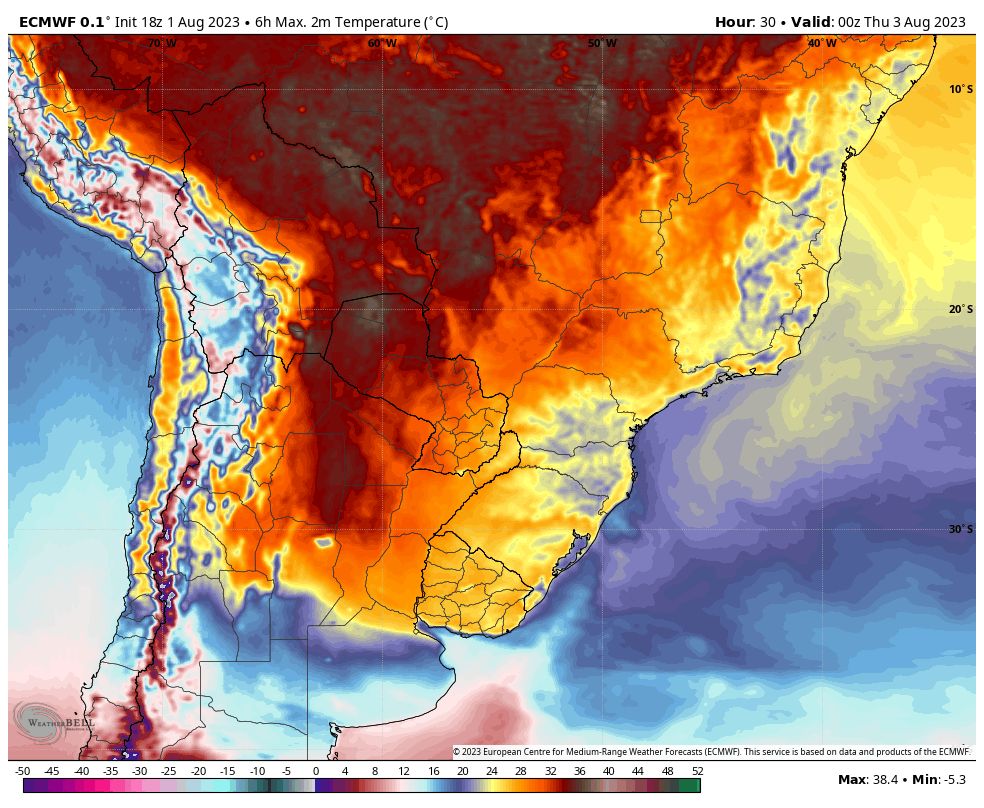It’s midwinter, but it’s over 100 degrees in South America
Listen 4 min Comment on this story Comment Gift Article Share
It’s the middle of winter in South America, but that hasn’t kept the heat away in Chile, Argentina and surrounding locations. Multiple spells of oddly hot weather have roasted the region in recent weeks. The latest spell early this week has become the most intense, pushing the mercury above 100 degrees Fahrenheit, while setting an August record for Chile.
In Buenos Aires, where the average high on Aug. 1 is 58 degrees (14 Celsius), it surpassed 86 (30 Celsius) on Tuesday.
“South America is living one of the extreme events the world has ever seen,” weather historian Maximiliano Herrera tweeted, adding, “This event is rewriting all climatic books.”
The most extreme conditions have occurred in the southern half of the continent, and particularly in the Andes Mountains region.
Temperatures Tuesday rose past 95 degrees (35 Celsius) in numerous locations, including at elevations of about 3,500 to 4,500 feet in the Andes foothills. In some cases, the temperature crested above 100 degrees (38 Celsius) after leaping from morning lows in the 30s and 40s (single-digits Celsius).
Advertisement
Some places have even reached all-time maximums — surpassing summer temperatures, even though it is winter. This has occurred in locations with 20 to 30 years of climate data available, showing how exceptional this heat is compared with recent decades.
What’s going on?
Like many other portions of the globe, record heat has visited parts of South America repeatedly in recent weeks. The big difference from its northern neighbors is that it’s winter there.
Parts of Brazil began to bake in mid-July, establishing record highs for the month as temperatures rose to at least 100 degrees (upper 30s Celsius). There was another spell of unusual heat during the third week of the month, which brought a slew of July records to Argentina, Bolivia, Paraguay and Uruguay.
A powerful zone of high pressure, or heat dome, centered over Paraguay is dominating the weather. It extends east to west across the south-central part of the continent.
Advertisement
Abnormally warm winter temperatures have also been observed in Australia, Africa and some island regions. These hot and persistent high-pressure zones have become more probable with climate change, according to scientists.
Exceptional ongoing heat
August in the Southern Hemisphere is equivalent to February in the Northern Hemisphere. It shouldn’t be hot, let alone scorching.
Weather historian Thierry Goose tweeted that this was an “extraordinary winter heatwave” for Chile as the temperature climbed to 101.7 degrees (38.7 Celsius), a national record for August.
Vicuña and Chiguinto in the central part of Chile, about 230 and 320 miles north of Santiago, respectively, both reached that mark Tuesday.
Temperatures in the afternoon reached 4o to 45 degrees above normal (22 to 25 Celsius) for the date, and in some cases a bit more. Overnight lows have been exceptionally warm as well, ranging from above freezing in the mountains to as high as the 70s (mid-20s Celsius) in lower elevations.
Many locations in Argentina also saw highs of 86 to 95 degrees (30 to 35 Celsius). Buenos Aires set a daily record for the start of August, with its high of 86.2 degrees (30.1 Celsius), which was more than 9 degrees (5 Celsius) above the previous daily record and nearly twice as warm as it normally is on the date. The thermometer rose to 98 degrees (37.2 Celsius) in the coastal city of Rivadavia.
Advertisement
The current heat spell will peak over the next few days. It began in late July, bringing record temperatures as high as 98.6 degrees (37 Celsius) to Paraguay earlier in the week.
More to come
Like other global hot spots that refuse to cool off for long, South America’s wintertime warmth is set to persist.
Large zones of similarly extreme temperature are expected to last at least into the weekend as high pressure continues. Highs between 95 and 104 degrees (35 and 40 Celsius) are a good bet in the hottest spots for days to come.
While cooler weather is increasingly possible with time, especially in southeastern portions of South America, temperatures are forecast to remain 18 to 36 degrees (10 to 20 Celsius) above average in the Andes region for as long as reliable forecasts extend.
Source: The Washington Post


